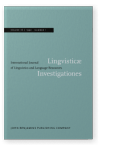Vol. 16:1 (1992) ► pp.99–124
The Collectives in French
A Linguistic Investigation
Comme nous l'avons déjà souligné (Michaux 1990), le pluriel est un phénomène complexe dans la mesure où il se reflète à différents niveaux dans la langue. Il faut en effet distinguer le pluriel exprimé au sein de la phrase du pluriel tel qu'il interagit avec le référent du mot. Dans ce deuxième cas — le pluriel au niveau du référent — il faut distinguer trois classes interactives et complémentaires: les noms comptables, les termes de masse et les collectifs. C'est sur ce troisième groupe que se penche cet article. Nous avons tout d'abord voulu mieux comprendre leurs caractéristiques morphologiques, syntaxiques et sémantiques de façon à pouvoir en donner une classification exhaustive. Nous envisageons ensuite et dans le cadre de ce classement les interactions des collectifs avec les termes de masse et les noms comptables ainsi que l'incidence de leur structure interne sur leur comportement syntaxique. Le but de cette analyse est donc de mieux cerner le problème des collectifs de façon à en donner une meilleure représentation lexicale.
Cited by
Cited by 10 other publications
This list is based on CrossRef data as of 3 april 2024. Please note that it may not be complete. Sources presented here have been supplied by the respective publishers. Any errors therein should be reported to them.
